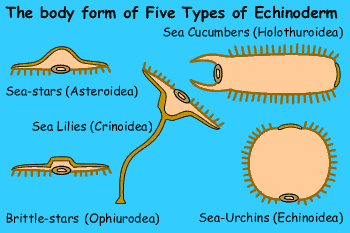|
|
Echinoderms
Echinoderms form a large group of animals that contain the Sea Stars, Brittle Stars, Crinoids, Sea Urchins, and Holothurians (Sea Cucumbers).
Many Echinoderm groups are found in the intertidal zone along the south-eastern Australian shore, although not a large number of species.
The word echinoderm means "echino" = spiny, and "derm" = skin.
The major body plan for echinoderms is radially symmetrical, meaning that the more or less equal units are arranged in a circle around a central disc, rather than being bilaterally symmetrical like most other animals.
Many echinoderms are based on a five-unit pattern, so they have a pentamerous (penta = five, mer = part) radial symmetry.

Most seastars have a five arm pattern, although along the New South Wales rocky shores, it is the Eight-armed Seastar which is the most common. The five-armed Small Green Seastar is the next most common, followed by the Eleven-armed Seastar which usually has between 7 to 14 unequal sized arms, many in a state of regeneration.
The most common brittle star is Ophionereis schayeri which may grow to 300 mm across and has long, thin, dramatically banded arms.
Crinoids, which are also called sea-lilies or feather-stars, have long slender arms with many side branches which look like feathers. Crinoids are different to other echinoderms because their mouth is in the centre of the top surface, and along the top of the each arm is a groove along the midline. When food particles are caught by the arms, they are propelled along the channels in the arms towards the mouth. Crinoids may occasionally be found on rocky shores when the spring tide is at its lowest.
Sea Urchins, Heart Urchins and Sand Dollars are surrounded by calcareous skeletal plates called ossicles, which combine to form a globular test. All wall plates carry moveable spines, hinged onto knob shaped tubercles. Sea Urchins move on hydraulically driven tube feet.
Most Holothurians (sea cucumbers) have an elongated, thickened, worm-like leathery body. They have a "head" which contains the mouth-parts and a "tail" which contains the anus. Sea cucumbers also have a dorsal and a ventral surface. Holothurains may be deposit-feeders or filter-feeders. Respiratory water is both brought in and expelled through the anus by muscular contraction.
| For more information on Echninoderms visit MESA Echinoderms |
Home
Page
Taxonomy
Biogeography
Rocky Shores
Tidal Levels
Intertidal Zonation
Environmental Factors
Biological
Factors
Feeding Relationships
Activities
Glossary
References
 Life
on Australian Seashores
Life
on Australian Seashores
by Keith Davey (C) 2000
Learning Consultant
- Media
The University of Newcastle
email at australian_seashores@hotmail.com
Scientific Consultant: Phil
Colman
site created 01.01.98 : updated 01.04.2000
